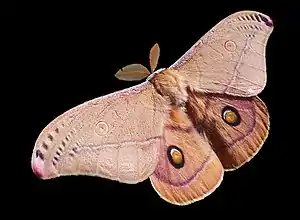峨眉
Chinese
| lofty; name of a mountain | eyebrow; upper margin | ||
|---|---|---|---|
| trad. (峨眉) | 峨 | 眉 | |
| simp. #(峨眉) | 峨 | 眉 | |
| alternative forms | 峨嵋 | ||

峨眉。

note how the feelers of this moth resemble the peaks of Mount Emei (pictured above)
Etymology
峨眉 derives from the word 蛾眉 (“the feathery feelers of a moth”), so named because the peaks of Mount Emei do in fact resemble the feelers of a moth (see pictures). The "insect" radical (虫) on the left side of the first character 蛾 was later replaced with the "mountain" radical (山). Thus, 蛾 eventually became 峨, so as to denote the mountain. The "mountain" radical can be optionally added to the second character 眉. Both 峨嵋 and 峨眉 have been used through the centuries.
Pronunciation
Proper noun
峨眉
- (~山) Mount Emei
- (~鄉) Emei (a rural township in Hsinchu County, Taiwan)